B.C.’s forestry watchdog is calling on the provincial government to undertake better planning of recreation sites in the bush.
Almost 80 per cent of B.C., consisting of Crown lands outside of parks, is under management of the provincial Ministry of Forests, Lands and Natural Resource Operations.
“These areas provide significant recreation and tourism opportunities, including hiking, hunting, fishing, mountain biking, backcountry skiing and more,” said Kevin Kriese, board chair, Forest Practices Board.
"Forest recreation is important in B.C., both as a valued part of residents' lifestyles and for the economic benefits derived from tourism.”
A special report developed by the Forest Practices Board found there has been very little in the way of planning related to recreation assets in public forests in the past 20 years.
The provincial agency responsible for managing recreation sites and trails, Recreation Sites and Trails B.C., has been reporting an “unprecedented demand for services” and has been burdened with work from the provincial government that is outside its original mandate.
The agency has responded to the workload by entering partnerships with volunteer organizations, but still those partners report frustration due to bureaucracy. The heavy workload means RSTBC staff have little time to plan.
The Forest Practices Board also found that conflicts are happening with increasing frequency amongst recreation groups and with industry.
The board says they often get complaints from residents who run cross flagging tape or painted cutblock boundaries on what they considered established trails.
“They are very upset that licensees could contemplate harvesting that would disturb the trails. Upon investigation, the board often finds that these trails have never been officially established,” the board says.
The agency is designating about 100 new recreation sites and trails per year and authorizing construction, maintenance or rehabilitation of another 100 annually, but can't keep up.
Conflicts between motorized and non-motorized recreation groups and issues with access to recreation sites via industry-maintained logging roads are also problems.
All these issues could be somewhat prevented with some planning at the provincial level, the board said.
The board recommended the government collect better information about recreation resources, conduct planning for recreation resources that involves First Nations and stakeholders and set objectives for specific recreation site to ensure they are protected from the impacts of forestry activities.
"Managing recreation sites and trails is important, but needs to be complemented with better planning for recreation on the remainder of the land base," Kriese said.



